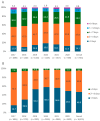Factors Associated with the Prolonged Use of Donor Human Milk at the Da Nang Hospital for Women and Children in Vietnam
- PMID: 39771023
- PMCID: PMC11676046
- DOI: 10.3390/nu16244402
Factors Associated with the Prolonged Use of Donor Human Milk at the Da Nang Hospital for Women and Children in Vietnam
Abstract
Background and objectives: Donor human milk (DHM) from a human milk bank (HMB) is used to feed low-birthweight (LBW) and preterm infants when mothers cannot provide their own breastmilk. The misuse of DHM could interfere with mothers' breastmilk and weaken breastfeeding efforts. This study aimed to identify factors behind prolonged DHM usage during the first six years of Vietnam's first HMB.
Methods: Data were extracted from the Da Nang HMB's digital monitoring system. We defined prolonged DHM use as four or more days in the neonatal unit and two or more days in postnatal wards.
Results: Over six years, 25,420 infants received DHM, with 45.3% of the infants being female, 54.7% being male, 70.0% being born via cesarean section, and 77.2% being full-term. In the neonatal unit (n = 7001), 38.0% of infants used DHM for ≥4 days. Adjusted odds ratios (aORs) for prolonged use were 0.14 for infants weighing <1000 g, 0.78 for infants weighing 1000-<1500 g, and 0.67 for infants weighing ≥2000 g (p < 0.01), compared to those weighing 1500-<2000 g. Compared to gestational ages of 32-<34 weeks, the aORs were 0.26 for <28 weeks, 0.71 for 34-<37 weeks, and 0.35 for ≥37 weeks (p < 0.01). In postnatal wards (n = 18,419), 53.1% of infants used DHM for ≥2 days. Compared to term, normal-weight infants, the aORs were 1.25 for LBW-preterm, 1.17 for LBW-term, and 1.21 for normal-weight-preterm infants (p < 0.05). Prolonged DHM use was associated with cesarean births in neonatal units (aOR 2.24, p < 0.01) and postnatal wards (aOR 1.44, p < 0.01).
Conclusions: DHM is used briefly to bridge nutritional gaps and transition to mothers' breastmilk, but LBW, preterm births, and cesarean births are linked to prolonged use. Healthcare providers should support those at risk of prolonged DHM use and prioritize reducing unnecessary cesarean births.
Keywords: breastfeeding; cesarean births; donor milk; human milk bank; infant; low birthweight; preterm births.
Conflict of interest statement
The authors declare no conflicts of interest.
Figures


Similar articles
-
Cost analysis of establishing and operating the first human milk bank at Da Nang Hospital for Women and Children in Vietnam: an activity-based costing ingredients study.Int Breastfeed J. 2024 Jul 6;19(1):47. doi: 10.1186/s13006-024-00657-6. Int Breastfeed J. 2024. PMID: 38970117 Free PMC article.
-
The cost of using donor human milk in the NICU to achieve exclusively human milk feeding through 32 weeks postmenstrual age.Breastfeed Med. 2013 Jun;8(3):286-90. doi: 10.1089/bfm.2012.0068. Epub 2013 Jan 16. Breastfeed Med. 2013. PMID: 23323965 Free PMC article.
-
Characteristics and factors influencing the volume of breastmilk donated by women to the first human milk bank in Vietnam.Front Glob Womens Health. 2023 Oct 2;4:1185097. doi: 10.3389/fgwh.2023.1185097. eCollection 2023. Front Glob Womens Health. 2023. PMID: 37849562 Free PMC article.
-
Donor human milk versus infant formula for low-risk infants: a systematic review.Pediatr Res. 2025 Jan;97(1):81-91. doi: 10.1038/s41390-024-03309-x. Epub 2024 Jun 6. Pediatr Res. 2025. PMID: 38844541 Free PMC article.
-
The effect of donor human milk on the length of hospital stay in very low birthweight infants: a systematic review and meta-analysis.Int Breastfeed J. 2020 Oct 28;15(1):89. doi: 10.1186/s13006-020-00332-6. Int Breastfeed J. 2020. PMID: 33115488 Free PMC article.
Cited by
-
Application of a locally developed open-access digital monitoring system for the human milk bank network in Vietnam.Int Breastfeed J. 2025 Jul 8;20(1):54. doi: 10.1186/s13006-025-00745-1. Int Breastfeed J. 2025. PMID: 40629436 Free PMC article.
References
-
- Lutter C.K. Reference Module in Food Science. Elsevier; Amsterdam, The Netherlands: 2022. Breastfeeding. - DOI
-
- World Health Organization . Guidelines on Optimal Feeding of Low Birth-Weight Infants in Low-and Middle-Income Countries. World Health Organization; Geneva, Switzerland: 2011. - PubMed
-
- Tableau Human Milk Bank Global Map. [(accessed on 24 November 2022)]. Available online: https://public.tableau.com/app/profile/human.milk.bank.global.map/viz/Hu....
MeSH terms
Grants and funding
LinkOut - more resources
Full Text Sources
Medical

